Nesomyrmex angulatus
| Nesomyrmex angulatus | |
|---|---|

| |
| Scientific classification | |
| Kingdom: | Animalia |
| Phylum: | Arthropoda |
| Class: | Insecta |
| Order: | Hymenoptera |
| Family: | Formicidae |
| Subfamily: | Myrmicinae |
| Tribe: | Crematogastrini |
| Genus: | Nesomyrmex |
| Species group: | angulatus |
| Species: | N. angulatus |
| Binomial name | |
| Nesomyrmex angulatus (Mayr, 1862) | |
| Subspecies | |
| |
| Synonyms | |
| |
An arid habitat species predominantly found on the trunk of trees or the lower vegetation, rarely on the ground. It nests in pre-existing cavities of dead wood. In Benin, Taylor et al. (2018) found it on Anacardium occidentale, mango (Mangifera indica) (under bark at 3.5m) and Isoberlinia doka.
Identification
Hita Garcia et al. (2017) - The following character combination distinguishes N. angulatus from the other members of the group: in profile mesosomal dorsum forming a single, uninterrupted flat surface without any trace a of metanotal groove; petiolar peduncle short; body colour yellow to very light brown.
Nesomyrmex angulatus together with Nesomyrmex grisoni are easily separable from the other members of the group on the basis of the dorsal mesosomal outline, which is an uninterrupted, flat surface without any trace of a metanotal groove. The separation of N. angulatus from N. grisoni is less clear though. As Bolton (1982) stated in his revision, the only differentiating character is body colour, which is yellowish in N. angulatus and dark brown to black in N. grisoni. In general, body coloration is a rather weak diagnostic character and extremely variable in many ant species, and it is likely that both species are actually conspecific and the differently coloured forms represent geographic or ecological variants. The latter seems probable if one considers that N. angulatus is predominantly an arid-adapted species, while N. grisoni appears to prefer humid rain forests. Nevertheless, at the moment we hesitate to synonymise the two species and prefer to keep them separate for the following reasons. First, while there is a lot of material of N. angulatus in many museums, there is not much of N. grisoni, making comparative analyses challenging.
Csősz and Fisher (2016) - Workers of N. angulatus can be convincingly separated from those of Nesomyrmex clypeatus based on the lack of median clypeal notch in the former species. Nesomyrmex angulatus differs from species of bidentatus-complex and devius-complex (Nesomyrmex devius, Nesomyrmex exiguus, Nesomyrmex fragilis, Nesomyrmex gracilis and Nesomyrmex hirtellus) by having sharp anterolateral pronotal angles and a numeric key, FRS/CS ratio yields perfect separation between workers of N. angulatus and members of bidentatus-complex.
Sharaf et al. (2017) Arabian Peninsula - The following character combination distinguishes N. angulatus from the other members of the group in the Arabian Peninsula: third mandibular tooth relatively larger and better developed; anterior clypeal lobe always conspicuously de-veloped, convex and rounded, never with a small median triangular projection; clypeus with median longitudinal carina; pronotum anterodorsally without sharp, dentate corners; in profile mesosomal dorsum forming a single, uninterrupted flat surface without any trace of metanotal groove; petiole with very well developed node.
This species exhibits remarkable variability throughout its distributional range, most notably in the shape of the petiolar node (Bolton 1982, Hita Garcia et al. 2017), but it is also relatively variable in body size and eye size. It is likely that the material currently understood to be N. angulatus is actually a complex of cryptic species.
Keys including this Species
- Key to Nesomyrmex of southern Africa
- Key to Afrotropical Nesomyrmex
- Key to Malagasy Nesomyrmex angulatus group workers
- Key to Afrotropical Nesomyrmex angulatus group workers
- Key to Arabian Nesomyrmex
Distribution
Hita Garcia et al (2017) - This species has by far the widest distribution range within the N. angulatus group, and likely represents the most widespread Nesomyrmex species on a global scale. It is found in the majority of African countries, as well as on the Arabian Peninsula and in most of the Malagasy region.
Csősz and Fisher (2016) - In the Malagasy zoogeographical region, this species is known to occur in coastal dry forests, mangroves and the coastal scrub of the northern, dry area of Madagascar and on adjacent islands in the Mozambique channel. Worldwide, N. angulatus has spread to the eastern Africa and the Middle East.
Latitudinal Distribution Pattern
Latitudinal Range: 35.674444° to -28.38333°.
| North Temperate |
North Subtropical |
Tropical | South Subtropical |
South Temperate |
- Source: AntMaps
Distribution based on Regional Taxon Lists
Afrotropical Region: Benin, Botswana, Comoros, Djibouti, Eritrea, Ethiopia, Gambia, Ghana, Kenya, Malawi, Mozambique, Niger, Nigeria, Saudi Arabia, South Africa, Sudan, Uganda, United Republic of Tanzania, Yemen, Zimbabwe.
Malagasy Region: Madagascar, Mayotte, Seychelles.
Palaearctic Region: Algeria, Egypt (type locality), Israel, Libya, Oman, Tunisia.
Distribution based on AntMaps
Distribution based on AntWeb specimens
Check data from AntWeb
Countries Occupied
| Number of countries occupied by this species based on AntWiki Regional Taxon Lists. In general, fewer countries occupied indicates a narrower range, while more countries indicates a more widespread species. |
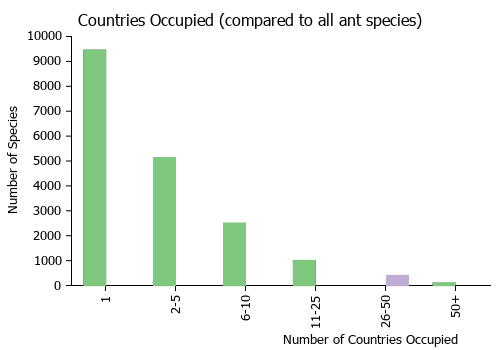
|
Estimated Abundance
| Relative abundance based on number of AntMaps records per species (this species within the purple bar). Fewer records (to the left) indicates a less abundant/encountered species while more records (to the right) indicates more abundant/encountered species. |

|
Habitat
Hita Garcia et al (2017) - Nesomyrmex angulatus has been collected from a variety of habitat types, such as tropical dry forest, coastal scrub, mangrove forest, savannah, and Acacia woodland. In general it seems as if the species prefers comparatively arid environments.
Biology
Hita Garcia et al (2017) - Nesomyrmex angulatus seems to prefer comparatively arid environments. In addition, it is predominantly found on the trunk of trees or the lower vegetation, rarely on the ground, and it nests in pre-existing cavities of dead wood (Bolton 1982; Mbanyana & Robertson 2008).
Bolton (1982) - Arnold (1916: 259) noted that he only found angulatus on the trunks of trees but personal observation has shown that it also occurs in leaf litter samples and log mould. However, the species does seem to prefer to nest clear of the ground when possible, as colonies are often found in West Africa in cocoa pods which are still attached to the tree, and a sample from Malawi was collected in Swartzia pods.
Collingwood and Agosti (1996) - The species was found in Yemen in partially rotten branches.
Castes
Worker
   
| |
| . | Owned by Museum of Comparative Zoology. |
 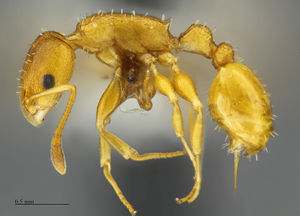  
| |
| . | Owned by Museum of Comparative Zoology. |
Images from AntWeb
   
| |
| Worker. Specimen code casent0134948. Photographer Erin Prado, uploaded by California Academy of Sciences. | Owned by CAS, San Francisco, CA, USA. |
   
| |
| Syntype of Nesomyrmex angulatus. Worker. Specimen code casent0101794. Photographer April Nobile, uploaded by California Academy of Sciences. | Owned by MHNG, Geneva, Switzerland. |
   
| |
| Worker. Specimen code casent0137608. Photographer Erin Prado, uploaded by California Academy of Sciences. | Owned by CAS, San Francisco, CA, USA. |
Queen
Images from AntWeb
   
| |
| Queen (alate/dealate). Specimen code casent0178058. Photographer Erin Prado, uploaded by California Academy of Sciences. | Owned by CAS, San Francisco, CA, USA. |
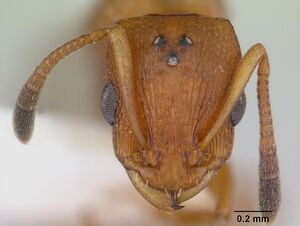  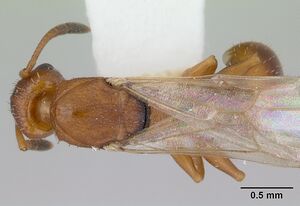 
| |
| Queen (alate/dealate). Specimen code casent0178297. Photographer April Nobile, uploaded by California Academy of Sciences. | Owned by LACM, Los Angeles, CA, USA. |
 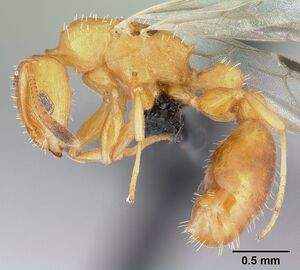   
| |
| Queen (alate/dealate). Specimen code casent0147246. Photographer Erin Prado, uploaded by California Academy of Sciences. | Owned by CAS, San Francisco, CA, USA. |
Male
Images from AntWeb
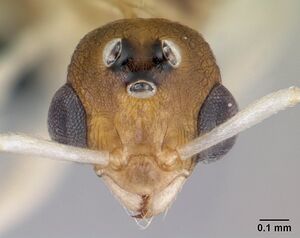     
| |
| Male (alate). Specimen code casent0147245. Photographer Erin Prado, uploaded by California Academy of Sciences. | Owned by CAS, San Francisco, CA, USA. |
Nomenclature
The following information is derived from Barry Bolton's Online Catalogue of the Ants of the World.
- angulatus. Leptothorax angulatus Mayr, 1862: 739 (w.) EGYPT. Santschi, 1914b: 107 (q.). Combination in L. (Goniothorax): Emery, 1896g: 58 (footnote); in Nesomyrmex: Bolton, 2003: 272. Senior synonym of concolor, ilgii, latinodis: Bolton, 1982: 324. See also: Mbanyana & Robertson, 2008: 38. Current subspecies: nominal plus lybica.
- ilgii. Leptothorax angulatus r. ilgii Forel, 1894b: 82 (w.) ETHIOPIA. Santschi, 1912c: 148 (q.). Combination in L. (Goniothorax): Wheeler, W.M. 1922a: 891. Junior synonym of angulatus: Bolton, 1982: 324.
- concolor. Leptothorax angulatus var. concolor Santschi, 1914b: 107, fig. 15 (w.) KENYA. Emery, 1915g: 16 (q.m.). Junior synonym of angulatus: Bolton, 1982: 324.
Unless otherwise noted the text for the remainder of this section is reported from the publication that includes the original description.
Hita Garcia et al. (2017) - We are not fully convinced that all the material currently listed and identified as N. angulatus represents the same species. On the basis of some recent collections from Kenya and Mozambique we were able to observe a lot of morphological variation within and between localities. As already noted by Bolton (1982), the shape of the petiolar node seems to be especially variable. Consequently, we cannot rule out the possibility of dealing with a complex of more or less cryptic species. At the same time it is possible that N. angulatus is not only a very successful and widespread, but also an extremely variable species. The solution to this problem is not the aim of this study, since it requires the accumulation of an extensive amount of material from all over Africa, the Arabian Peninsula, and the Malagasy region.
Description
Worker
Csősz and Fisher (2016) - Body color: yellow; brown. Body color pattern: concolorous; only clava darker. Absolute cephalic size (mm): 688 [630, 724], (nD33). Cephalic length vs. maximum width of head capsule (CL/CWb): 1.258 [1.218, 1.327]. Postocular distance vs. cephalic length (PoOc/CL): 0.371 [0.359, 0.386]. Postocular sides of cranium contour frontal view orientation: converging posteriorly. Postocular sides of cranium contour frontal view shape: feebly convex. Vertex contour line in frontal view shape: straight; feebly convex. Vertex sculpture: main sculpture rugoso-reticulate, ground sculpture areolate. Gena contour line in frontal view shape: convex. Genae contour from anterior view orientation: converging; strongly converging. Gena sculpture: rugoso-reticulate with areolate ground sculpture. Concentric carinae laterally surrounding antennal foramen count: present. Eye length vs. absolute cephalic size (EL/CS): 0.280 [0.262, 0.317]. Frontal carina distance vs. absolute cephalic size (FRS/CS): 0.325 [0.310, 0.343]. Longitudinal carinae on median region of frons: present. Smooth median region on frons: absent. Antennomere count: 12. Scape length vs. absolute cephalic size (SL/CS): 0.818 [0.783, 0.866]. Facial area of the scape absolute setal angle: setae absent, pubescence only. Median clypeal notch: absent. Ground sculpture of submedian area of clypeus: smooth. Median carina of clypeus: present. Lateral carinae of clypeus: present. Median anatomical line of propodeal spine angle value to Weber length in lateral view: 58-62°. Spine length vs. absolute cephalic size (SPST/CS): 0.273 [0.225, 0.304]. Minimum spine distance vs. absolute cephalic size (SPBA/CS): 0.325 [0.299, 0.354]. Apical spine distance vs. absolute cephalic size (SPTI/CS): 0.334 [0.294, 0.360]. Propodeal spine shape: straight; curving upward. Anterolateral pronotal corner: present. Apical distance of pronotal spines vs. absolute cephalic size (PSTI/CS): 0.690 [0.584, 0.736]. Metanotal depression: absent. Dorsal region of mesosoma sculpture: rugulose with areolate ground sculpture. Lateral region of pronotum sculpture: areolate ground sculpture, superimposed by dispersed rugae. Mesopleuron sculpture: areolate ground sculpture superimposed by dispersed rugulae. Metapleuron sculpture: areolate ground sculpture superimposed by dispersed rugulae. Petiole width vs. absolute cephalic size (PEW/CS): 0.410 [0.376, 0.445]. Dorsal region of petiole sculpture: ground sculpture areolate, main sculpture rogoso-reticulate. Postpetiole width vs. absolute cephalic size (PPW/CS): 0.488 [0.443, 0.546]. Dorsal region of postpetiole sculpture: ground sculpture areolate, main sculpture dispersed rugose.
Bolton (1982) - TL 3.1-3.8, HL 0.70-0.90, HW 0.56-0.74, CI 75-85, SL 0.50-0.66, SI 88-97, PW 0.40-0.56, AL 0.82-1.08 (65 measured).
Mandibles delicately but densely longitudinally striate, the striation usually distinct but sometimes superficial. Median clypeal lobe extensive, broad, covering the bases of the mandibles and having its anterior margin conspicuously arched-convex. Median clypeal carina fine, not strongly developed but usually discernible, only rarely the carina partially or wholly effaced. Antennal scrobes absent. Frontal carinae absent but in some the frontal lobe followed on one or both sides by a weak rugular line which runs back on the head. Maximum diameter of eyes 0.17-0.22, about 0.27-0.33 x HW and with 13 or more ommatidia in the longest row. With the head in full-face view the sides narrower in front of the eyes than behind, slightly convergent anteriorly. Sides of head behind eyes shallowly convex, slightly convergent posteriorly and meeting the occipital margin in a blunted angle. Occipital margin transverse to very shallowly concave, with a slightly projecting rim above the occipital foramen which is visible in full-face view. With the alitrunk in profile the dorsum forming a single shallowly convex to almost flat surface, without trace of a metanotal impression. Propodeum armed with a pair of triangular teeth or short broad spines of variable size. In general the teeth are about as long as their basal width and slightly upcurved, but individuals with spines longer than their basal width are fairly common. Specimens with the propodeal armament reduced to short broad teeth, where they are shorter than the basal width, are less common. Metapleural lobes low and rounded. In dorsal view the alitrunk with angulate to weakly dentate pronotal corners. Mesonotum narrower than pronotum and the sides of the propodeum diverging to the level of the spiracle and then converging to the bases of the propodeal teeth. Petiole in profile shaped as in Fig. 8, with a short anterior peduncle which has a triangular dentiform anteroventral process. Dorsal surface of peduncle with a denticulate process in front of the level of the spiracle on each side. Anterodorsal angle of node quite sharply defined, the posterodorsal angle much broader and bluntly rounded. Petiole node in dorsal view variable in shape and size. Usually the node about as broad as long, rarely slightly longer than broad but quite commonly obviously broader than long, in some cases approaching the postpetiole in width. Dorsum of head covered with a fine dense reticulate-punctulate ground-sculpture which in some samples is superficial and granular in appearance. Superimposed on this are very fine irregular rugulae which frequently form a narrow reticulum occipitally and sometimes also on the sides of the head. Dorsal surfaces of alitrunk, petiole and postpetiole with fine granular or punctulate ground-sculpture and with disorganized fine rugulae. The rugular sculpture is usually distinctive but in some individuals may be partially effaced. Base of first gastral tergite generally with a superficial reticular pattern but sometimes almost completely smooth. All dorsal surfaces of head and body with numerous short stout blunt hairs; such hairs absent from the appendages. Colour yellow, frequently with the antennal club darker.
Mbanyana and Robertson (2008) - HL 0.672–0.811, HW 0.565–0.692, HW1 0.610–0.736, CI 78–87, SL 0.487–0.613, SI 84–92, PW 0.423–0.541, ML 0.785–1.087, EL 0.169–0.197, EI 28–30 (5 of 81 measured).
Description matches that of Bolton (1982) except for few additional characters. Sculpture on the dorsum of head is not only reticulate-punctulate but also with longitudinal striations, which are well defined near the inner margin of the eyes.
Type Material
Csősz and Fisher (2016) - “Sinai”' [Egypt], collect. G.Mayr. Lectotype, designated by Bolton 1982: 324 (1w Naturhistorisches Museum Wien, Vienna, CASENT0914922).
References
- Báthori, F., Seifert, B., Heinze, J., Kiran, K., Karaman, C., Csősz, S. 2024. Taxonomy of the Palearctic socially parasitic Temnothorax (Myrmoxenus) ants (Hymenoptera: Formicidae). PLOS ONE, 19(10), e0308712 (doi:10.1371/journal.pone.0308712).
- Bolton, B. 1982. Afrotropical species of the myrmecine ant genera Cardiocondyla, Leptothorax, Melissotarsus, Messor and Cataulacus (Formicidae). Bulletin of the British Museum (Natural History). Entomology, 46: 307-370 (page 324, Senior synonym of concolor, ilgii and latinodis)
- Bolton, B. 2003. Synopsis and Classification of Formicidae. Mem. Am. Entomol. Inst. 71: 370pp (page 272, Combination in Nesomyrmex)
- Borowiec, L. 2014. Catalogue of ants of Europe, the Mediterranean Basin and adjacent regions (Hymenoptera: Formicidae). Genus (Wroclaw) 25(1-2): 1-340.
- Collingwood, C. A. and D. Agosti. 1996. Formicidae (Insecta: Hymenoptera) of Saudi Arabia (part 2). Fauna Saudi Arabia. 15:300-385.
- Csosz, S. & Fisher, B.L. 2016. Taxonomic revision of the Malagasy members of the Nesomyrmex angulatus species group using the automated morphological species delineation protocol NC-PART-clustering. PeerJ 4:e1796 doi:10.7717/peerj.1796
- Emery, C. 1896g. Studi sulle formiche della fauna neotropica. XVII-XXV. Bull. Soc. Entomol. Ital. 28: 33-107 (page 58, Combination in L. (Goniothorax) (footnote))
- Hita Garcia, F., Mbanyana, N., Audisco, T.L. & Alpert, G.D. 2017. Taxonomy of the ant genus Nesomyrmex Wheeler (Formicidae, Myrmicinae) in the Afrotropical region, with a review of current species groups and description of a new species of the N. angulatus group from Mozambique. European Journal of Taxonomy 258: 1–31 (DOI:10.5852/ejt.2017.258).
- Mayr, G. 1862. Myrmecologische Studien. Verh. K-K. Zool.-Bot. Ges. Wien 12: 649-776 (page 739, worker described)
- Mbanyana, N. and Robertson, H.G. 2008. Review of the ant genus Nesomyrmex in southern Africa. African Natural History 4: 35-55.
- Santschi, F. 1914b. Voyage de Ch. Alluaud et R. Jeannel en Afrique Orientale, 1911-1912. Résultats scientifiques. Insectes Hyménoptères. II. Formicidae. Paris: Libr. A. Schulz, pp. 41-148. (page 107, queen described)
- Sharaf, M.R., Akbar, S.A., Aldawood, A.S., Hita Garcia, F. 2017. Review of the ant genus Nesomyrmex Wheeler, 1910 (Hymenoptera, Formicidae, Myrmicinae) from the Arabian Peninsula. African Invertebrates 58: 21–37 (DIO 10.3897/AfrInvertebr.58.12782).
- Sharaf, M.R., Mohamed, A.A., Al Dhafer, H.M., Aldawood, A.S. 2020. Nesomyrmex micheleae, a new ant species (Hymenoptera: Formicidae) from the Dhofar Governorate, Oman, with a synoptic list, distribution map and key to the Arabian Nesomyrmex. Journal of Natural History 54(5-6), 351-365 (doi:10.1080/00222933.2020.1762013).
- Taylor, B., Agoinon, N., Sinzogan, A., Adandonon, A., Kouaguou, Y. N., Bello, S., Wargui, R., Anato, F., Ouagoussounon, I., Houngbo, H., Tchibozo, S., Todjihounde, R., Vayssieres, J.F. 2018. Records of ants (Hymenoptera: Formicidae) from the Republic of Benin, with particular reference to the mango farm ecosystem. Journal of Insect Biodiversity 8(1): 6-29 (doi:10.12976/jib/2018.08.1.2).
References based on Global Ant Biodiversity Informatics
- Bakr R. F. A., H. H. Fadl, R. M. Badawy, and M. R. Sharaf. 2007. Myrmecophile insects associated with some ant species (Hymenoptera : Formicidae )in Egypt. The second international conference of economic entomology (Entomological Society of Egypt) ,Cairo, Egypt, 8-11 December, (1): 205-233.
- Belshaw R., and B. Bolton. 1994. A survey of the leaf litter ant fauna in Ghana, West Africa (Hymenoptera: Formicidae). Journal of Hymenoptera Research 3: 5-16.
- Belshaw R., and B. Bolton. 1994. A survey of the leaf litter ant fauna in Ghana, West Africa (Hymenoptera: Formicidae). Journal of Hymenoptera Research. 3: 5-16.
- Bernard F. 1950. Contribution à l'étude de l'Aïr. Hyménoptères Formicidae. Mém. Inst. Fr. Afr. Noire 10: 284-294.
- Bernard F. 1953. Les fourmis du Tassili des Ajjer. Pp. 121-250 in: Bernard, F. (ed.) 1953. Mission scientifique au Tassili des Ajjer (1949). Volume I. Recherches zoologiques et médicales. Paris: P. Lechevalier, 302 pp.
- Bernard, F. "Les insectes sociaux du Fezzân. Comportement et biogéographie." En: Bernard, F., Peyerimhoff, P. de Mission sc (1948): 87-200.
- Bolton B. 1982. Afrotropical species of the myrmicine ant genera Cardiocondyla, Leptothorax, Melissotarsus, Messor and Cataulacus (Formicidae). Bulletin of the British Museum (Natural History). Entomology 45: 307-370.
- Borowiec L. 2014. Catalogue of ants of Europe, the Mediterranean Basin and adjacent regions (Hymenoptera: Formicidae). Genus (Wroclaw) 25(1-2): 1-340.
- Borowiec L., and S. Salata. 2018. Notes on ants (Hymenoptera: Formicidae) from Gambia (Western Africa). Annals of the Upper Silesian Museum in Bytom Entomology 26: 1-13.
- Collingwood, C. A., and Donat Agosti. "Formicidae (Insecta: Hymenoptera) of Saudi Arabia (Part 2)." Fauna of Saudi Arabia 15 (1996): 300-385.
- Csősz S., and B. L. Fisher. 2016. Taxonomic revision of the Malagasy members of the Nesomyrmex angulatus species group using the automated morphological species delineation protocol NC-PART-clustering. PeerJ, DOI 10.7717/peerj.1796
- El-Hawagry M. S., M. W. Khalil, M. R. Sharaf, H. H. Fadl, and A. S. Aldawood. 2013. A preliminary study on the insect fauna of Al-Baha Province, Saudi Arabia, with descriptions of two new species. ZooKeys 274: 188. doi:10.3897/zookeys.274.4529
- Emery C. 1895. Mission scientifique de M. Ch. Alluaud dans le territoire de Diego-Suarez (Madagascar-nord) (Avril-août 1893). Formicides. Annales de la Société Entomologique de Belgique 39: 336-345.
- Emery C. 1915. Formiche raccolte nell'Eritrea dal Prof. F. Silvestri. Bollettino del Laboratorio di Zoologia Generale e Agraria della Reale Scuola Superiore d'Agricoltura. Portici 10: 3-26.
- Finzi B. 1939. Materiali zoologici dell'Eritrea raccolti da G. Müller durante la spedizione dell'Istituto Sieroterapico Milanese e conservati al Museo di Trieste. Parte III. Hymenoptera: Formicidae. Atti del Museo Civico di Storia Naturale di Trieste 14: 153-168.
- Finzi, B. "Risultati scientifici della spedizione di S. A. S. il Principe Alessandro della Torre e Tasso nell'Egitto e peninsola del Sinai. XI. Formiche." Bulletin de la Société Entomologique d'Egypte 20 (1936): 155-210.
- Fisher B. L. 1997. Biogeography and ecology of the ant fauna of Madagascar (Hymenoptera: Formicidae). Journal of Natural History 31: 269-302.
- Forel A. 1914. Formicides d'Afrique et d'Amérique nouveaux ou peu connus. Bulletin de la Société Vaudoise des Sciences Naturelles 50: 211-288.
- Garcia F.H., Wiesel E. and Fischer G. 2013.The Ants of Kenya (Hymenoptera: Formicidae)Faunal Overview, First Species Checklist, Bibliography, Accounts for All Genera, and Discussion on Taxonomy and Zoogeography. Journal of East African Natural History, 101(2): 127-222
- Hita Garcia F., Mbanyana N., Audisio T. L., and G. D. Alpert. 2017. Taxonomy of the ant genus Nesomyrmex Wheeler (Formicidae, Myrmicinae) in the Afrotropical region, with a review of current species groups and description of a new species of the N. angulatus group from Mozambique. European Journal of Taxonomy 258: 1–31.
- IZIKO South Africa Museum Collection
- Kugler J. 1988. The zoogeography of Israel. 9. The zoogeography of social insects of Israel and Sinai. Monographiae biologicae 62: 251-275.
- Madl M. 2019. Notes on the ant fauna of Eritrea (Insecta: Hymenoptera: Formicidae): type specimens deposited in the Natural History Museum Vienna (Austria) and a preliminary checklist. Ann. Naturhist. Mus. Wien, B 121: 9-18.
- Mbanyana N., and H. G. Robertson. 2008. Review of the ant genus Nesomyrmex (Hymenoptera: Formicidae: Myrmicinae) in southern Africa. African Natural History 4: 35-55.
- Menozzi C., M. Consani. 1952. Missione biologica Sagan-Omo diretta dal Prof. E. Zavattari. Hymenoptera Formicidae. Rivista di Biologia Coloniale 11: 57-71.
- Prins A. J. 1963. A list of the ants collected in the Kruger National Park with notes on their distribution. Koedoe 6: 91-108.
- Prins A. J. 1964. Revised list of the ants collected in the Kruger National Park. Koedoe 7: 77-93.
- Santschi, F. 1938. Quelques nouvelles fourmis d'Egypte. Bulletin de la Société Entomologique d'Egypte 21: 28-44.
- Santschi, F. "Fourmis de Tunisie capturées en 1906." Revue Suisse de Zoologie 15 (1907): 305-334.
- Santschi, F. "Quelques nouvelles variétés de fourmis africaines." Bulletin de la Société d' Histoire Naturelle de l' Afrique du Nord 3 (1912): 147-149.
- Santschi, F. 1907. Fourmis de Tunisie capturées en 1906. Revue Suisse de Zoologie 15: 305-334.
- Sharaf M. R., B. L. Fisher, H. M. Al Dhafer, A. Polaszek, and A. S. Aldawood. 2018. Additions to the ant fauna (Hymenoptera: Formicidae) of Oman: an updated list, new records and a description of two new species. Asian Myrmecology 10: e010004
- Sharaf M.R., S. A. Akbar, A. S. Aldawood, and F. Hita Garcia. 2017. Review of the ant genus Nesomyrmex Wheeler, 1910 (Hymenoptera, Formicidae, Myrmicinae) from the Arabian Peninsula. African Invertebrates 58(2): 21–37.
- Taylor B., N. Agoinon, A. Sinzogan, A. Adandonon, Y. N'Da Kouagou, S. Bello, R. Wargui, F. Anato, I. Ouagoussounon, H. Houngbo, S. Tchibozo, R. Todjhounde, and J. F. Vayssieres. 2018. Records of ants (Hymenoptera: Formicidae) from the Republic of Benin, with particular reference to the mango farm ecosystem. Journal of Insect Biodiversity 8(1): 006–029.
- Vonshak M., and A. Ionescu-Hirsch. 2009. A checklist of the ants of Israel (Hymenoptera: Formicidae). Israel Journal of Entomology 39: 33-55.
- Weber N. A. 1942. A biocoenose of papyrus heads (Cyperus papyrus). Ecology 23: 115-119.
- Wheeler W. M. 1922. Ants of the American Museum Congo expedition. A contribution to the myrmecology of Africa. IX. A synonymic list of the ants of the Malagasy region. Bulletin of the American Museum of Natural History 45: 1005-1055
- Wheeler W. M. 1922. Ants of the American Museum Congo expedition. A contribution to the myrmecology of Africa. VIII. A synonymic list of the ants of the Ethiopian region. Bulletin of the American Museum of Natural History 45: 711-1004
- Yeo K., T. Delsinne, S. Komate, L. L. Alonso, D. Aidara, and C. Peeters. 2016. Diversity and distribution of ant assemblages above and below ground in a West African forest–savannah mosaic (Lamto, Cote d’Ivoire). Insectes Sociaux DOI 10.1007/s00040-016-0527-6

